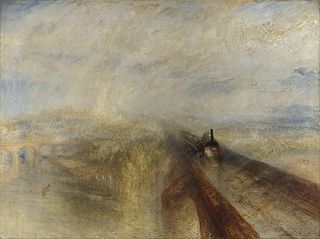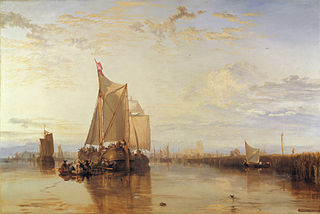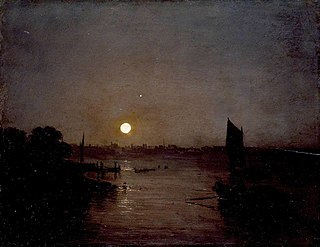
Joseph Mallord William Turner, known in his time as William Turner, was an English Romantic painter, printmaker and watercolourist. He is known for his expressive colouring, imaginative landscapes and turbulent, often violent marine paintings. He left behind more than 550 oil paintings, 2,000 watercolours, and 30,000 works on paper. He was championed by the leading English art critic John Ruskin from 1840, and is today regarded as having elevated landscape painting to an eminence rivalling history painting.

Rain, Steam, and Speed – The Great Western Railway is an oil painting by the 19th-century British painter J. M. W. Turner.

Dido building Carthage, or The Rise of the Carthaginian Empire is an oil on canvas painting by J. M. W. Turner. The painting is one of Turner's most important works, greatly influenced by the luminous classical landscapes of Claude Lorrain. Turner described it as his chef d'oeuvre. First exhibited at the Royal Academy summer exhibition in 1815, Turner kept the painting until he left it to the nation in the Turner Bequest. It has been held by the National Gallery in London since 1856.

The Beacon Light is a painting by J. M. W. Turner. It was given to the National Museum of Wales by the Davies sisters. For some time it was regarded as a fake, but is now accepted as authentic.

The Fifth Plague of Egypt is an 1800 oil painting by Romantic English artist Joseph Mallord William Turner currently in the permanent collection at the Indianapolis Museum of Art. Despite its title, it depicts Moses cursing the Egyptians with a plague of hail and fire, known as the seventh plague. It is one of the first works in which Turner uses an extreme representation of landscape and nature to explore the sublime.

The Dort, or Dort or Dordrecht: The Dort packet-boat from Rotterdam becalmed is an 1818 painting by J. M. W. Turner, based on drawings made by him in mid September 1817. It shows a view of the harbour of Dordrecht. It is the finest example of the influence of Dutch marine painting on Turner's work.

Port Ruysdael is an 1826 oil on canvas painting by the English painter J. M. W. Turner. It is in the collection of the Yale Center for British Art in New Haven.

Whalers is an 1845 painting by British artist J. M. W. Turner. Done in oil on canvas, the work depicts a whaling ship and her launches pursuing a whale. Originally created with the hope that collector Elhanan Bicknell would purchase it, the work is currently found in the collection of the Metropolitan Museum of Art.

Norham Castle, Sunrise is an oil-on-canvas painting by English painter J. M. W. Turner, created around 1845. The painting depicts Norham Castle, overlooking the River Tweed, the border between England and Scotland. The painting was bequeathed to the National Gallery of British Art as part of the Turner Bequest in 1856. It remains in the collection to this day. It was one of the artist's last paintings, and falls within his "Modernist" period. This piece is well known for Turner's attentiveness to dawn light, and the softened silhouette it brings.

The Golden Bough is a painting from 1834 by the English painter J. M. W. Turner. It depicts the episode of the golden bough from the Aeneid by Virgil. It is in the collection of the Tate galleries.

Venice, from the Porch of Madonna della Salute is a 19th century oil painting by J. M. W. Turner. Done in oil on canvas, the painting depicts an imagined image of Venice, as the view shown is not realistic. The painting was inspired by one of Turner's three visits to Venice, and showcases Turner's skill as a maritime artist. The work is in the collection of the Metropolitan Museum of Art.

Landscape with Windmill and Rainbow is a painting attributed to J. M. W. Turner, painted c. 1795–1800. It has the dimensions of 70.5 by 90.2 cm. It is believed to have been created at least partially in a painting by Thomas Gainsborough. It is held at the Tate Gallery, in London.

Moonlight, a Study at Millbank is an oil painting by J. M. W. Turner, painted c. 1797. The nocturne is painted in oils on a mahogany board which measures 31.4 cm × 40.3 cm. It has been held by the Tate Gallery since 1910.

Aeneas and the Sibyl, Lake Avernus is a painting by J. M. W. Turner, painted c. 1798.

Caernarvon Castle is a painting by J. M. W. Turner, painted c. 1798.

View in Wales: Mountain Scene with Village and Castle - Evening is a painting by J. M. W. Turner, painted c. 1799–1800.

A Beech Wood with Gypsies Seated in the Distance is a painting by J. M. W. Turner, painted c. 1799–1801.

Welsh Mountain Landscape is a painting by J. M. W. Turner, painted c. 1799–1800.

Peace – Burial at Sea is a painting in oils on canvas by the English Romantic artist J. M. W. Turner (1775–1851), first exhibited in 1842. The work is a memorial tribute to Turner's contemporary the Scottish painter Sir David Wilkie (1786–1841). The canvas depicts Wilkie's burial at sea. This work was intended as a companion piece to War. The Exile and the Rock Limpet which alludes to the sordid demise of the former Emperor of France Napoleon Bonaparte. The two works are characterized by sharply contrasting colors and tones: War utilizes a strident yellow and red while Peace is painted a cool blend of white, blue and black.

The Shipwreck is a landscape painting by J. M. W. Turner in the collection of the Tate. It was completed around 1805, when it was exhibited in Turner's own gallery. The painting is an important example of the sublime in British art.




















